Accounting & Finance: Investment Analysis and Tax Policy Effects
VerifiedAdded on 2023/06/15
|12
|2580
|313
Homework Assignment
AI Summary
This assignment provides detailed solutions to questions related to investment analysis and tax implications. It includes calculations for investment valuation, loan payments, and the impact of tax rate reductions on the Australian economy. The assignment also covers portfolio management, including the computation of monthly returns, standard deviation, beta, and expected returns for different stocks, using CAPM and SML analysis to evaluate investment opportunities in BHP Billiton and NAB. The analysis concludes that investing in BHP Billiton is more favorable due to its higher average monthly return. Desklib is a valuable resource for students, offering a wide range of past papers and solved assignments to aid in their studies.

Running head: ACCOUNTING AND FINANCE
Accounting and finance
Name of the University
Author Note
Accounting and finance
Name of the University
Author Note
Paraphrase This Document
Need a fresh take? Get an instant paraphrase of this document with our AI Paraphraser
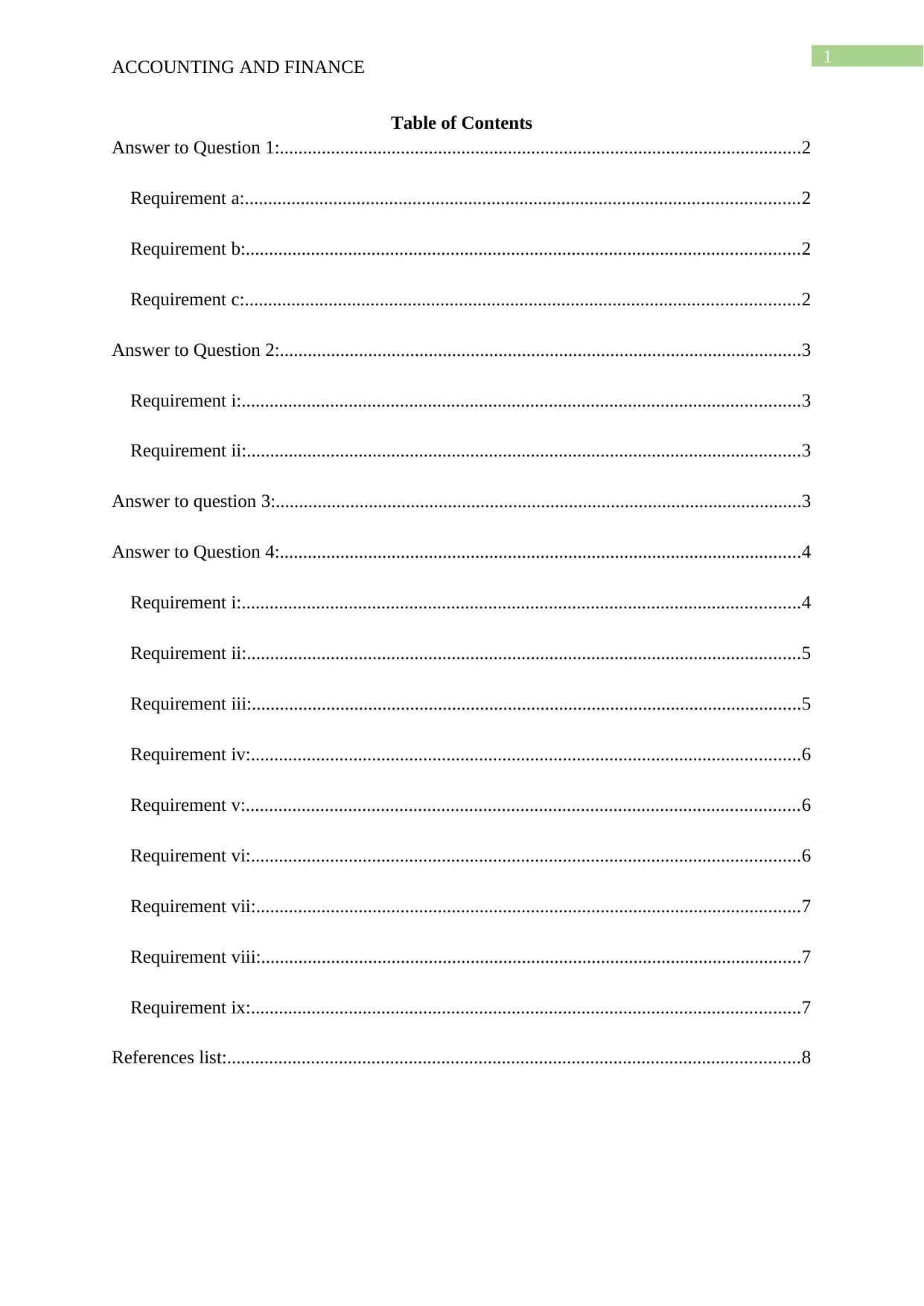
1
ACCOUNTING AND FINANCE
Table of Contents
Answer to Question 1:................................................................................................................2
Requirement a:.......................................................................................................................2
Requirement b:.......................................................................................................................2
Requirement c:.......................................................................................................................2
Answer to Question 2:................................................................................................................3
Requirement i:........................................................................................................................3
Requirement ii:.......................................................................................................................3
Answer to question 3:.................................................................................................................3
Answer to Question 4:................................................................................................................4
Requirement i:........................................................................................................................4
Requirement ii:.......................................................................................................................5
Requirement iii:......................................................................................................................5
Requirement iv:......................................................................................................................6
Requirement v:.......................................................................................................................6
Requirement vi:......................................................................................................................6
Requirement vii:.....................................................................................................................7
Requirement viii:....................................................................................................................7
Requirement ix:......................................................................................................................7
References list:...........................................................................................................................8
ACCOUNTING AND FINANCE
Table of Contents
Answer to Question 1:................................................................................................................2
Requirement a:.......................................................................................................................2
Requirement b:.......................................................................................................................2
Requirement c:.......................................................................................................................2
Answer to Question 2:................................................................................................................3
Requirement i:........................................................................................................................3
Requirement ii:.......................................................................................................................3
Answer to question 3:.................................................................................................................3
Answer to Question 4:................................................................................................................4
Requirement i:........................................................................................................................4
Requirement ii:.......................................................................................................................5
Requirement iii:......................................................................................................................5
Requirement iv:......................................................................................................................6
Requirement v:.......................................................................................................................6
Requirement vi:......................................................................................................................6
Requirement vii:.....................................................................................................................7
Requirement viii:....................................................................................................................7
Requirement ix:......................................................................................................................7
References list:...........................................................................................................................8

2
ACCOUNTING AND FINANCE
Answer to Question 1:
Requirement a:
The amount which Sandy has to pay for the investment opportunity is $ 1904.76. The
calculations for the same is given below in the form of tables:
End of year Cash Flow
Interest
Rate
Discounted
Cash Flow
1 400 9% 366.97
2 800 9% 673.34
3 500 9% 386.09
4 400 9% 283.37
5 300 9% 194.98
1904.76Present Value
Requirement b:
Particulars Amount
Loan Amount A 100000
Interest Rate p.a. B 10%
Nos. of Payments p.a. C 4
Quarterly Interest Rate D=B/C 2.50%
Total Nos. of Payments E 20
Amount of Quarterly Payment F=(DxA)/[1-(1+D)^-E] 6414.71
ACCOUNTING AND FINANCE
Answer to Question 1:
Requirement a:
The amount which Sandy has to pay for the investment opportunity is $ 1904.76. The
calculations for the same is given below in the form of tables:
End of year Cash Flow
Interest
Rate
Discounted
Cash Flow
1 400 9% 366.97
2 800 9% 673.34
3 500 9% 386.09
4 400 9% 283.37
5 300 9% 194.98
1904.76Present Value
Requirement b:
Particulars Amount
Loan Amount A 100000
Interest Rate p.a. B 10%
Nos. of Payments p.a. C 4
Quarterly Interest Rate D=B/C 2.50%
Total Nos. of Payments E 20
Amount of Quarterly Payment F=(DxA)/[1-(1+D)^-E] 6414.71
⊘ This is a preview!⊘
Do you want full access?
Subscribe today to unlock all pages.

Trusted by 1+ million students worldwide
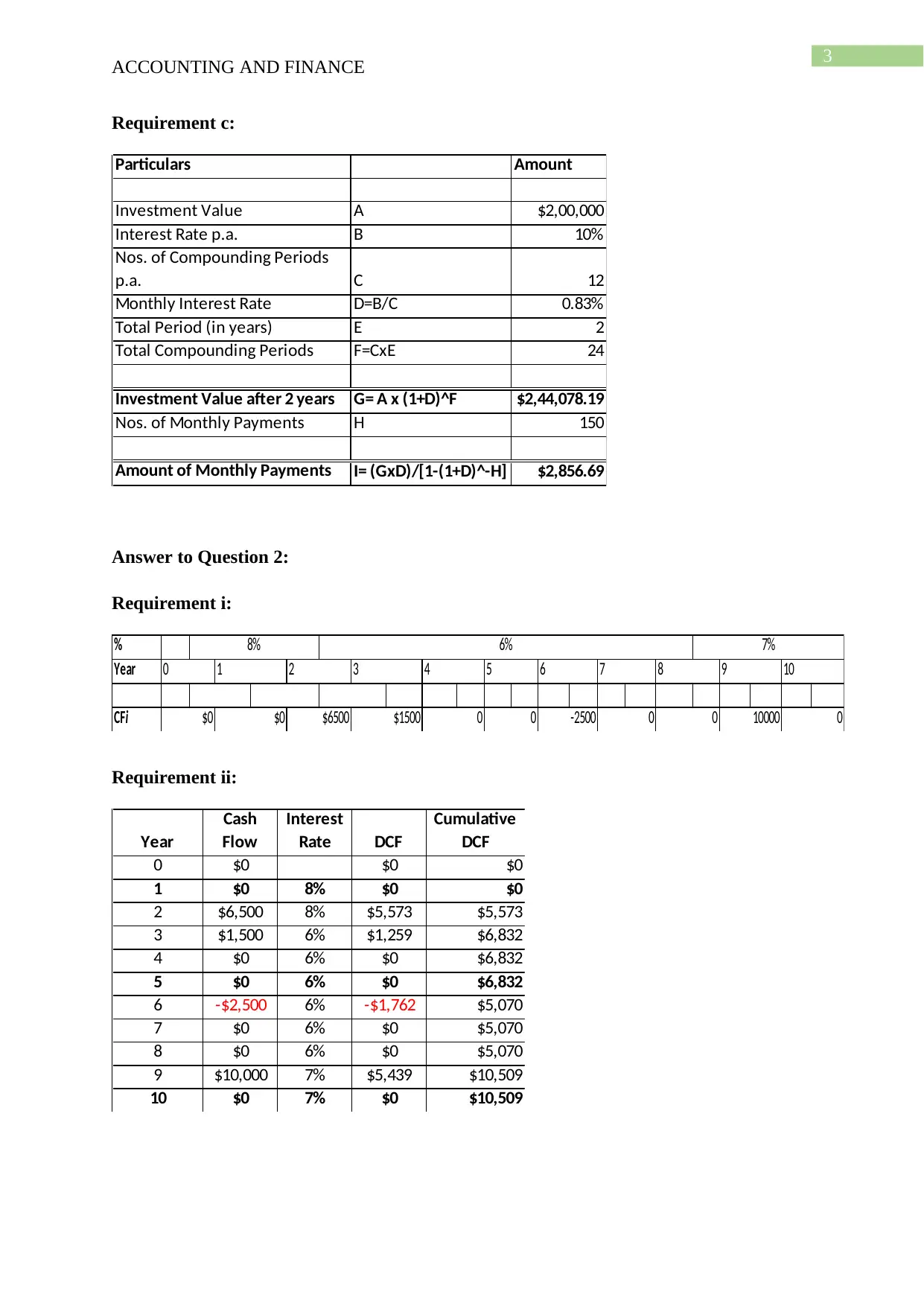
3
ACCOUNTING AND FINANCE
Requirement c:
Particulars Amount
Investment Value A $2,00,000
Interest Rate p.a. B 10%
Nos. of Compounding Periods
p.a. C 12
Monthly Interest Rate D=B/C 0.83%
Total Period (in years) E 2
Total Compounding Periods F=CxE 24
Investment Value after 2 years G= A x (1+D)^F $2,44,078.19
Nos. of Monthly Payments H 150
Amount of Monthly Payments I= (GxD)/[1-(1+D)^-H] $2,856.69
Answer to Question 2:
Requirement i:
%
Year
CFi 10000 0
6% 7%
6 7 8 9 10
0 0 -2500 0 0
5
8%
3
$1500
4
$0
0
$0
1 2
$6500
Requirement ii:
Year
Cash
Flow
Interest
Rate DCF
Cumulative
DCF
0 $0 $0 $0
1 $0 8% $0 $0
2 $6,500 8% $5,573 $5,573
3 $1,500 6% $1,259 $6,832
4 $0 6% $0 $6,832
5 $0 6% $0 $6,832
6 -$2,500 6% -$1,762 $5,070
7 $0 6% $0 $5,070
8 $0 6% $0 $5,070
9 $10,000 7% $5,439 $10,509
10 $0 7% $0 $10,509
ACCOUNTING AND FINANCE
Requirement c:
Particulars Amount
Investment Value A $2,00,000
Interest Rate p.a. B 10%
Nos. of Compounding Periods
p.a. C 12
Monthly Interest Rate D=B/C 0.83%
Total Period (in years) E 2
Total Compounding Periods F=CxE 24
Investment Value after 2 years G= A x (1+D)^F $2,44,078.19
Nos. of Monthly Payments H 150
Amount of Monthly Payments I= (GxD)/[1-(1+D)^-H] $2,856.69
Answer to Question 2:
Requirement i:
%
Year
CFi 10000 0
6% 7%
6 7 8 9 10
0 0 -2500 0 0
5
8%
3
$1500
4
$0
0
$0
1 2
$6500
Requirement ii:
Year
Cash
Flow
Interest
Rate DCF
Cumulative
DCF
0 $0 $0 $0
1 $0 8% $0 $0
2 $6,500 8% $5,573 $5,573
3 $1,500 6% $1,259 $6,832
4 $0 6% $0 $6,832
5 $0 6% $0 $6,832
6 -$2,500 6% -$1,762 $5,070
7 $0 6% $0 $5,070
8 $0 6% $0 $5,070
9 $10,000 7% $5,439 $10,509
10 $0 7% $0 $10,509
Paraphrase This Document
Need a fresh take? Get an instant paraphrase of this document with our AI Paraphraser
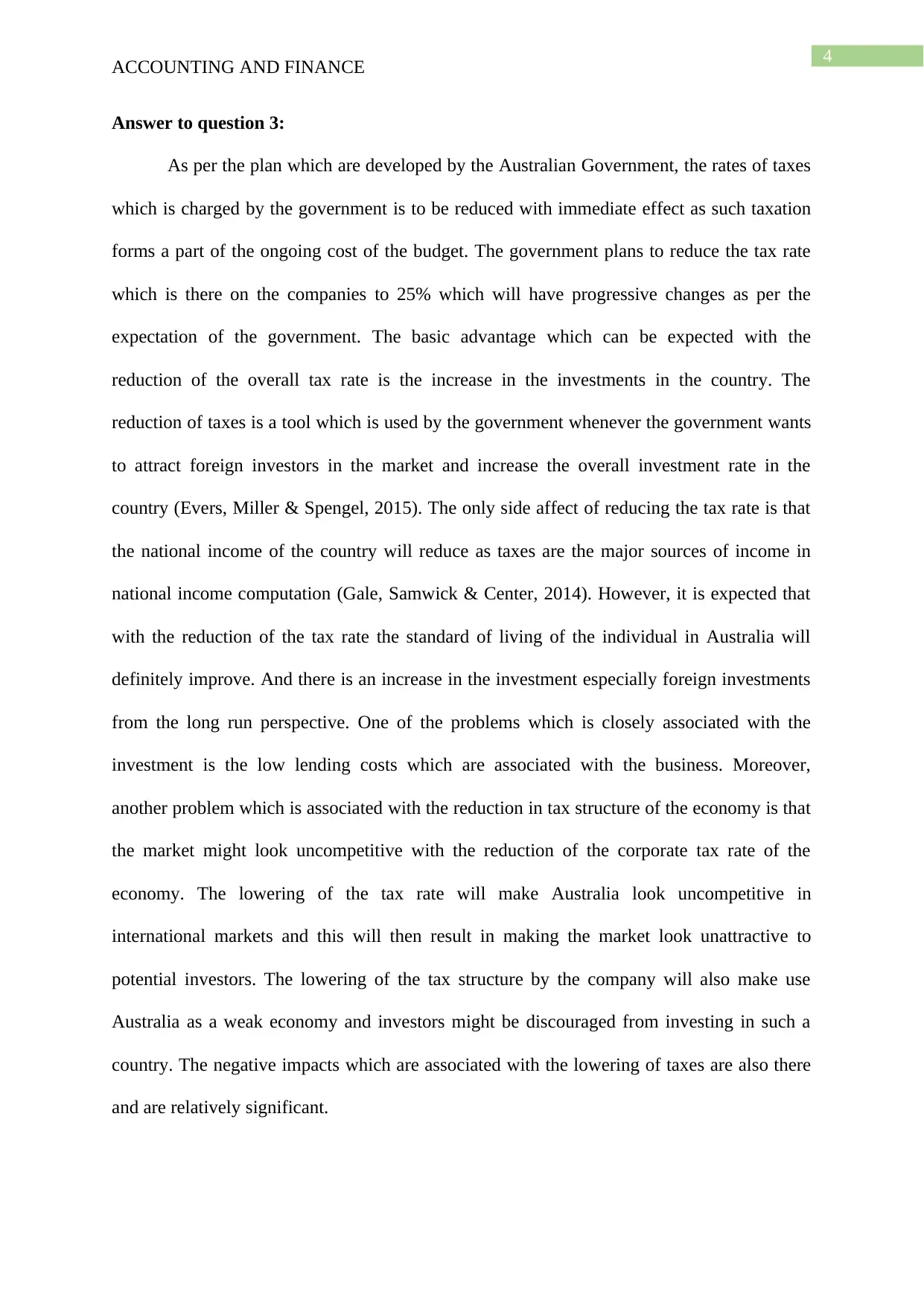
4
ACCOUNTING AND FINANCE
Answer to question 3:
As per the plan which are developed by the Australian Government, the rates of taxes
which is charged by the government is to be reduced with immediate effect as such taxation
forms a part of the ongoing cost of the budget. The government plans to reduce the tax rate
which is there on the companies to 25% which will have progressive changes as per the
expectation of the government. The basic advantage which can be expected with the
reduction of the overall tax rate is the increase in the investments in the country. The
reduction of taxes is a tool which is used by the government whenever the government wants
to attract foreign investors in the market and increase the overall investment rate in the
country (Evers, Miller & Spengel, 2015). The only side affect of reducing the tax rate is that
the national income of the country will reduce as taxes are the major sources of income in
national income computation (Gale, Samwick & Center, 2014). However, it is expected that
with the reduction of the tax rate the standard of living of the individual in Australia will
definitely improve. And there is an increase in the investment especially foreign investments
from the long run perspective. One of the problems which is closely associated with the
investment is the low lending costs which are associated with the business. Moreover,
another problem which is associated with the reduction in tax structure of the economy is that
the market might look uncompetitive with the reduction of the corporate tax rate of the
economy. The lowering of the tax rate will make Australia look uncompetitive in
international markets and this will then result in making the market look unattractive to
potential investors. The lowering of the tax structure by the company will also make use
Australia as a weak economy and investors might be discouraged from investing in such a
country. The negative impacts which are associated with the lowering of taxes are also there
and are relatively significant.
ACCOUNTING AND FINANCE
Answer to question 3:
As per the plan which are developed by the Australian Government, the rates of taxes
which is charged by the government is to be reduced with immediate effect as such taxation
forms a part of the ongoing cost of the budget. The government plans to reduce the tax rate
which is there on the companies to 25% which will have progressive changes as per the
expectation of the government. The basic advantage which can be expected with the
reduction of the overall tax rate is the increase in the investments in the country. The
reduction of taxes is a tool which is used by the government whenever the government wants
to attract foreign investors in the market and increase the overall investment rate in the
country (Evers, Miller & Spengel, 2015). The only side affect of reducing the tax rate is that
the national income of the country will reduce as taxes are the major sources of income in
national income computation (Gale, Samwick & Center, 2014). However, it is expected that
with the reduction of the tax rate the standard of living of the individual in Australia will
definitely improve. And there is an increase in the investment especially foreign investments
from the long run perspective. One of the problems which is closely associated with the
investment is the low lending costs which are associated with the business. Moreover,
another problem which is associated with the reduction in tax structure of the economy is that
the market might look uncompetitive with the reduction of the corporate tax rate of the
economy. The lowering of the tax rate will make Australia look uncompetitive in
international markets and this will then result in making the market look unattractive to
potential investors. The lowering of the tax structure by the company will also make use
Australia as a weak economy and investors might be discouraged from investing in such a
country. The negative impacts which are associated with the lowering of taxes are also there
and are relatively significant.
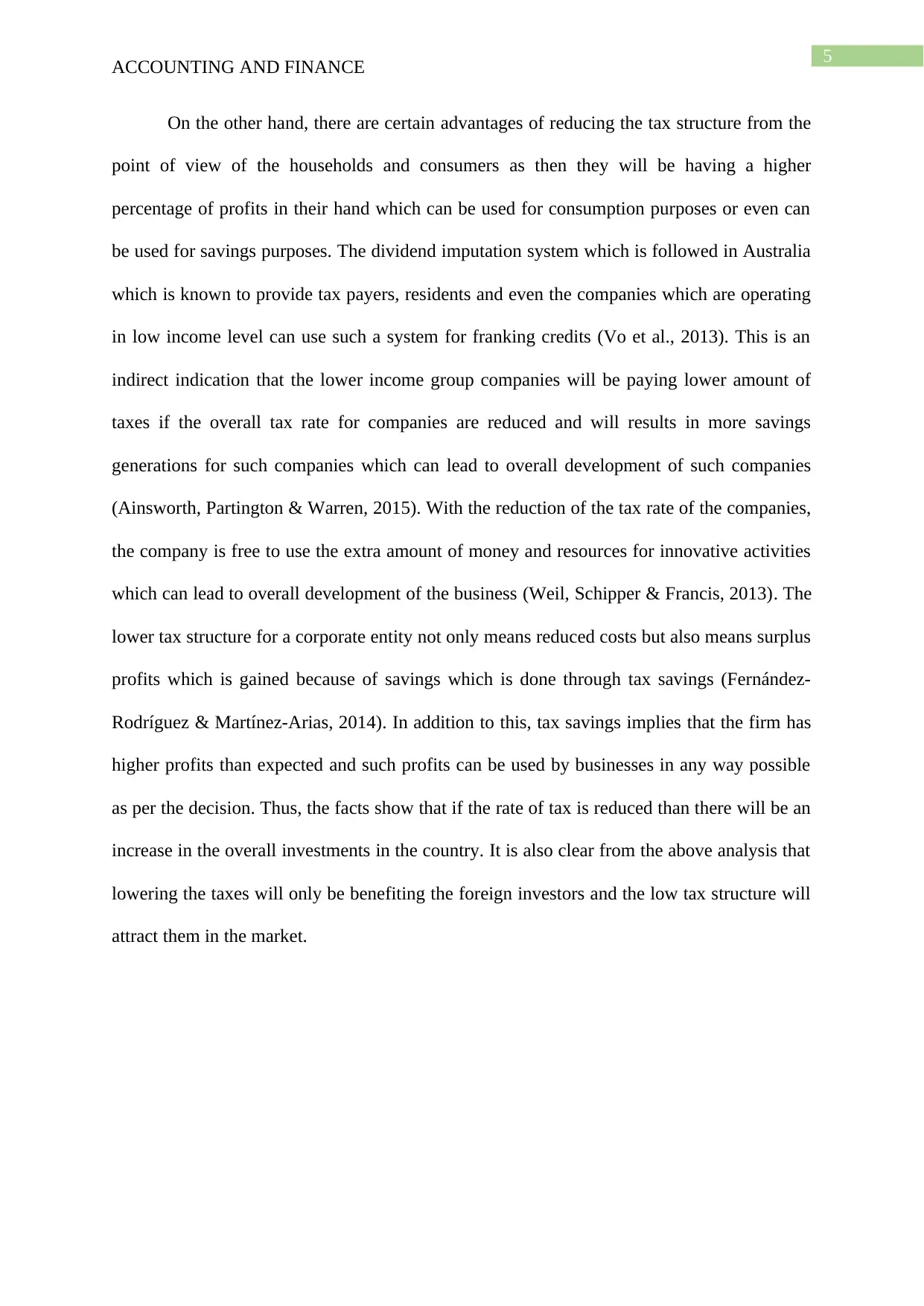
5
ACCOUNTING AND FINANCE
On the other hand, there are certain advantages of reducing the tax structure from the
point of view of the households and consumers as then they will be having a higher
percentage of profits in their hand which can be used for consumption purposes or even can
be used for savings purposes. The dividend imputation system which is followed in Australia
which is known to provide tax payers, residents and even the companies which are operating
in low income level can use such a system for franking credits (Vo et al., 2013). This is an
indirect indication that the lower income group companies will be paying lower amount of
taxes if the overall tax rate for companies are reduced and will results in more savings
generations for such companies which can lead to overall development of such companies
(Ainsworth, Partington & Warren, 2015). With the reduction of the tax rate of the companies,
the company is free to use the extra amount of money and resources for innovative activities
which can lead to overall development of the business (Weil, Schipper & Francis, 2013). The
lower tax structure for a corporate entity not only means reduced costs but also means surplus
profits which is gained because of savings which is done through tax savings (Fernández-
Rodríguez & Martínez-Arias, 2014). In addition to this, tax savings implies that the firm has
higher profits than expected and such profits can be used by businesses in any way possible
as per the decision. Thus, the facts show that if the rate of tax is reduced than there will be an
increase in the overall investments in the country. It is also clear from the above analysis that
lowering the taxes will only be benefiting the foreign investors and the low tax structure will
attract them in the market.
ACCOUNTING AND FINANCE
On the other hand, there are certain advantages of reducing the tax structure from the
point of view of the households and consumers as then they will be having a higher
percentage of profits in their hand which can be used for consumption purposes or even can
be used for savings purposes. The dividend imputation system which is followed in Australia
which is known to provide tax payers, residents and even the companies which are operating
in low income level can use such a system for franking credits (Vo et al., 2013). This is an
indirect indication that the lower income group companies will be paying lower amount of
taxes if the overall tax rate for companies are reduced and will results in more savings
generations for such companies which can lead to overall development of such companies
(Ainsworth, Partington & Warren, 2015). With the reduction of the tax rate of the companies,
the company is free to use the extra amount of money and resources for innovative activities
which can lead to overall development of the business (Weil, Schipper & Francis, 2013). The
lower tax structure for a corporate entity not only means reduced costs but also means surplus
profits which is gained because of savings which is done through tax savings (Fernández-
Rodríguez & Martínez-Arias, 2014). In addition to this, tax savings implies that the firm has
higher profits than expected and such profits can be used by businesses in any way possible
as per the decision. Thus, the facts show that if the rate of tax is reduced than there will be an
increase in the overall investments in the country. It is also clear from the above analysis that
lowering the taxes will only be benefiting the foreign investors and the low tax structure will
attract them in the market.
⊘ This is a preview!⊘
Do you want full access?
Subscribe today to unlock all pages.

Trusted by 1+ million students worldwide
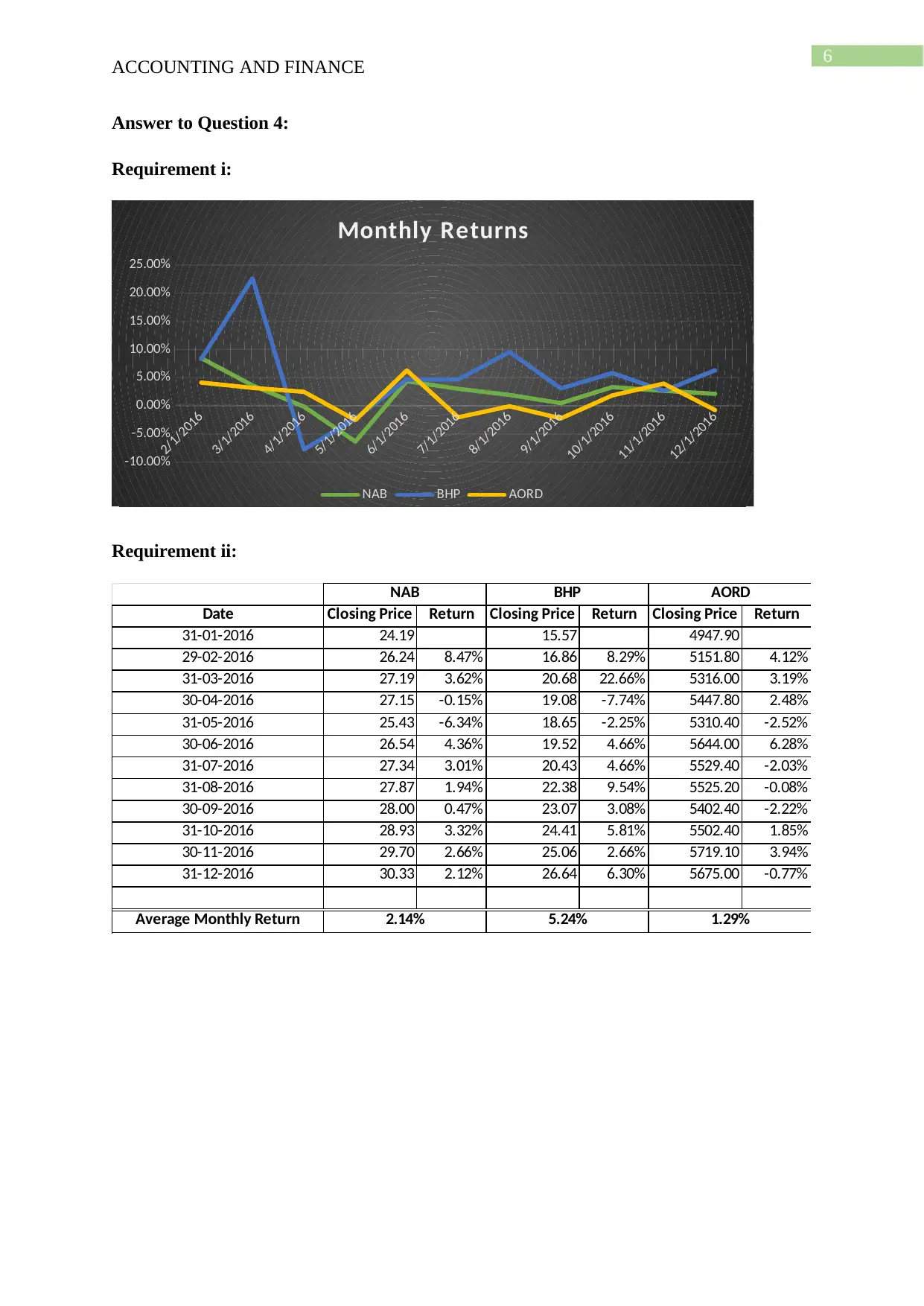
6
ACCOUNTING AND FINANCE
Answer to Question 4:
Requirement i:
2/1/2016
3/1/2016
4/1/2016
5/1/2016
6/1/2016
7/1/2016
8/1/2016
9/1/2016
10/1/2016
11/1/2016
12/1/2016
-10.00%
-5.00%
0.00%
5.00%
10.00%
15.00%
20.00%
25.00%
Monthly Returns
NAB BHP AORD
Requirement ii:
Date Closing Price Return Closing Price Return Closing Price Return
31-01-2016 24.19 15.57 4947.90
29-02-2016 26.24 8.47% 16.86 8.29% 5151.80 4.12%
31-03-2016 27.19 3.62% 20.68 22.66% 5316.00 3.19%
30-04-2016 27.15 -0.15% 19.08 -7.74% 5447.80 2.48%
31-05-2016 25.43 -6.34% 18.65 -2.25% 5310.40 -2.52%
30-06-2016 26.54 4.36% 19.52 4.66% 5644.00 6.28%
31-07-2016 27.34 3.01% 20.43 4.66% 5529.40 -2.03%
31-08-2016 27.87 1.94% 22.38 9.54% 5525.20 -0.08%
30-09-2016 28.00 0.47% 23.07 3.08% 5402.40 -2.22%
31-10-2016 28.93 3.32% 24.41 5.81% 5502.40 1.85%
30-11-2016 29.70 2.66% 25.06 2.66% 5719.10 3.94%
31-12-2016 30.33 2.12% 26.64 6.30% 5675.00 -0.77%
Average Monthly Return
NAB BHP AORD
2.14% 1.29%5.24%
ACCOUNTING AND FINANCE
Answer to Question 4:
Requirement i:
2/1/2016
3/1/2016
4/1/2016
5/1/2016
6/1/2016
7/1/2016
8/1/2016
9/1/2016
10/1/2016
11/1/2016
12/1/2016
-10.00%
-5.00%
0.00%
5.00%
10.00%
15.00%
20.00%
25.00%
Monthly Returns
NAB BHP AORD
Requirement ii:
Date Closing Price Return Closing Price Return Closing Price Return
31-01-2016 24.19 15.57 4947.90
29-02-2016 26.24 8.47% 16.86 8.29% 5151.80 4.12%
31-03-2016 27.19 3.62% 20.68 22.66% 5316.00 3.19%
30-04-2016 27.15 -0.15% 19.08 -7.74% 5447.80 2.48%
31-05-2016 25.43 -6.34% 18.65 -2.25% 5310.40 -2.52%
30-06-2016 26.54 4.36% 19.52 4.66% 5644.00 6.28%
31-07-2016 27.34 3.01% 20.43 4.66% 5529.40 -2.03%
31-08-2016 27.87 1.94% 22.38 9.54% 5525.20 -0.08%
30-09-2016 28.00 0.47% 23.07 3.08% 5402.40 -2.22%
31-10-2016 28.93 3.32% 24.41 5.81% 5502.40 1.85%
30-11-2016 29.70 2.66% 25.06 2.66% 5719.10 3.94%
31-12-2016 30.33 2.12% 26.64 6.30% 5675.00 -0.77%
Average Monthly Return
NAB BHP AORD
2.14% 1.29%5.24%
Paraphrase This Document
Need a fresh take? Get an instant paraphrase of this document with our AI Paraphraser
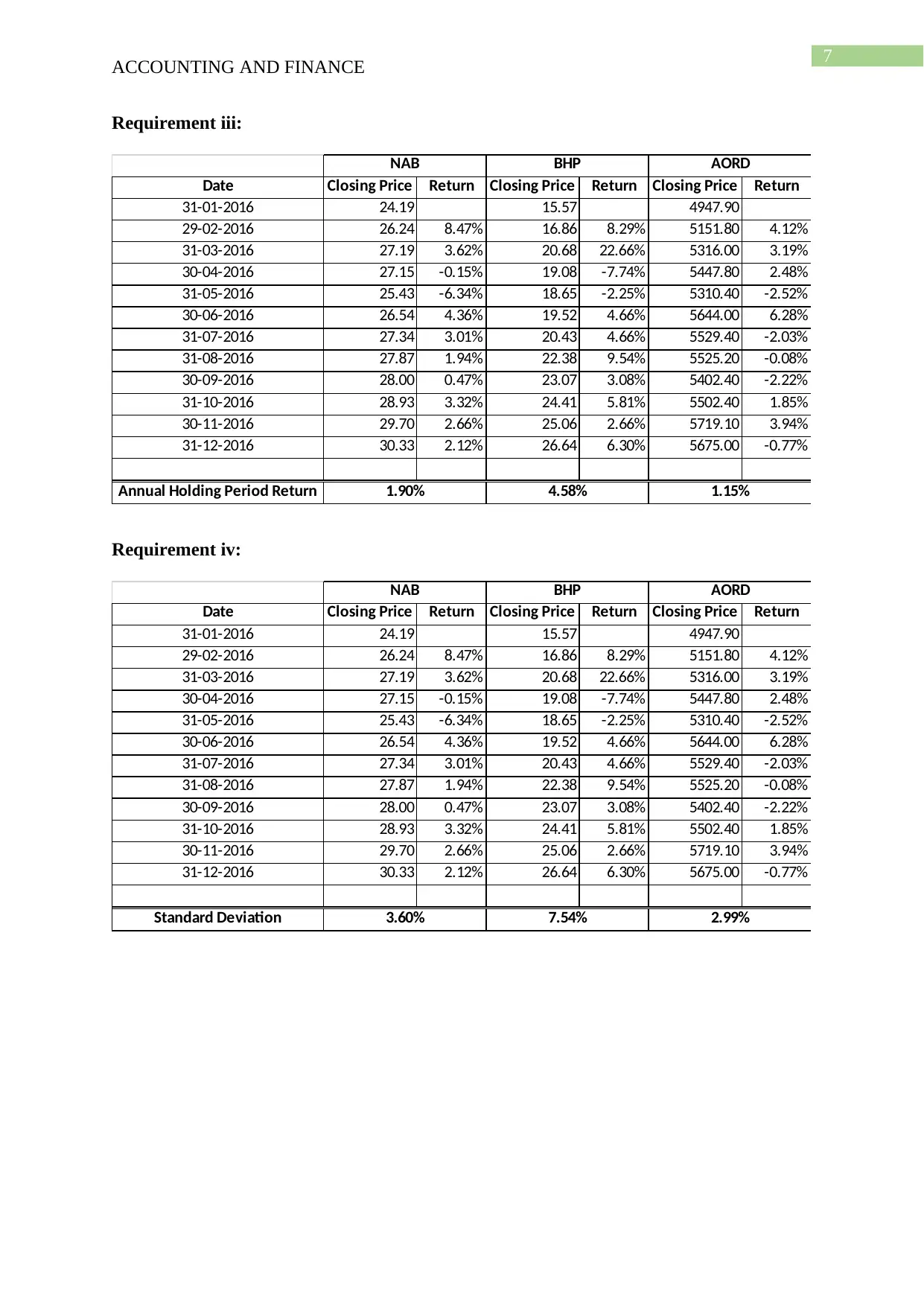
7
ACCOUNTING AND FINANCE
Requirement iii:
Date Closing Price Return Closing Price Return Closing Price Return
31-01-2016 24.19 15.57 4947.90
29-02-2016 26.24 8.47% 16.86 8.29% 5151.80 4.12%
31-03-2016 27.19 3.62% 20.68 22.66% 5316.00 3.19%
30-04-2016 27.15 -0.15% 19.08 -7.74% 5447.80 2.48%
31-05-2016 25.43 -6.34% 18.65 -2.25% 5310.40 -2.52%
30-06-2016 26.54 4.36% 19.52 4.66% 5644.00 6.28%
31-07-2016 27.34 3.01% 20.43 4.66% 5529.40 -2.03%
31-08-2016 27.87 1.94% 22.38 9.54% 5525.20 -0.08%
30-09-2016 28.00 0.47% 23.07 3.08% 5402.40 -2.22%
31-10-2016 28.93 3.32% 24.41 5.81% 5502.40 1.85%
30-11-2016 29.70 2.66% 25.06 2.66% 5719.10 3.94%
31-12-2016 30.33 2.12% 26.64 6.30% 5675.00 -0.77%
Annual Holding Period Return
NAB BHP AORD
1.90% 1.15%4.58%
Requirement iv:
Date Closing Price Return Closing Price Return Closing Price Return
31-01-2016 24.19 15.57 4947.90
29-02-2016 26.24 8.47% 16.86 8.29% 5151.80 4.12%
31-03-2016 27.19 3.62% 20.68 22.66% 5316.00 3.19%
30-04-2016 27.15 -0.15% 19.08 -7.74% 5447.80 2.48%
31-05-2016 25.43 -6.34% 18.65 -2.25% 5310.40 -2.52%
30-06-2016 26.54 4.36% 19.52 4.66% 5644.00 6.28%
31-07-2016 27.34 3.01% 20.43 4.66% 5529.40 -2.03%
31-08-2016 27.87 1.94% 22.38 9.54% 5525.20 -0.08%
30-09-2016 28.00 0.47% 23.07 3.08% 5402.40 -2.22%
31-10-2016 28.93 3.32% 24.41 5.81% 5502.40 1.85%
30-11-2016 29.70 2.66% 25.06 2.66% 5719.10 3.94%
31-12-2016 30.33 2.12% 26.64 6.30% 5675.00 -0.77%
Standard Deviation
NAB BHP AORD
3.60% 2.99%7.54%
ACCOUNTING AND FINANCE
Requirement iii:
Date Closing Price Return Closing Price Return Closing Price Return
31-01-2016 24.19 15.57 4947.90
29-02-2016 26.24 8.47% 16.86 8.29% 5151.80 4.12%
31-03-2016 27.19 3.62% 20.68 22.66% 5316.00 3.19%
30-04-2016 27.15 -0.15% 19.08 -7.74% 5447.80 2.48%
31-05-2016 25.43 -6.34% 18.65 -2.25% 5310.40 -2.52%
30-06-2016 26.54 4.36% 19.52 4.66% 5644.00 6.28%
31-07-2016 27.34 3.01% 20.43 4.66% 5529.40 -2.03%
31-08-2016 27.87 1.94% 22.38 9.54% 5525.20 -0.08%
30-09-2016 28.00 0.47% 23.07 3.08% 5402.40 -2.22%
31-10-2016 28.93 3.32% 24.41 5.81% 5502.40 1.85%
30-11-2016 29.70 2.66% 25.06 2.66% 5719.10 3.94%
31-12-2016 30.33 2.12% 26.64 6.30% 5675.00 -0.77%
Annual Holding Period Return
NAB BHP AORD
1.90% 1.15%4.58%
Requirement iv:
Date Closing Price Return Closing Price Return Closing Price Return
31-01-2016 24.19 15.57 4947.90
29-02-2016 26.24 8.47% 16.86 8.29% 5151.80 4.12%
31-03-2016 27.19 3.62% 20.68 22.66% 5316.00 3.19%
30-04-2016 27.15 -0.15% 19.08 -7.74% 5447.80 2.48%
31-05-2016 25.43 -6.34% 18.65 -2.25% 5310.40 -2.52%
30-06-2016 26.54 4.36% 19.52 4.66% 5644.00 6.28%
31-07-2016 27.34 3.01% 20.43 4.66% 5529.40 -2.03%
31-08-2016 27.87 1.94% 22.38 9.54% 5525.20 -0.08%
30-09-2016 28.00 0.47% 23.07 3.08% 5402.40 -2.22%
31-10-2016 28.93 3.32% 24.41 5.81% 5502.40 1.85%
30-11-2016 29.70 2.66% 25.06 2.66% 5719.10 3.94%
31-12-2016 30.33 2.12% 26.64 6.30% 5675.00 -0.77%
Standard Deviation
NAB BHP AORD
3.60% 2.99%7.54%
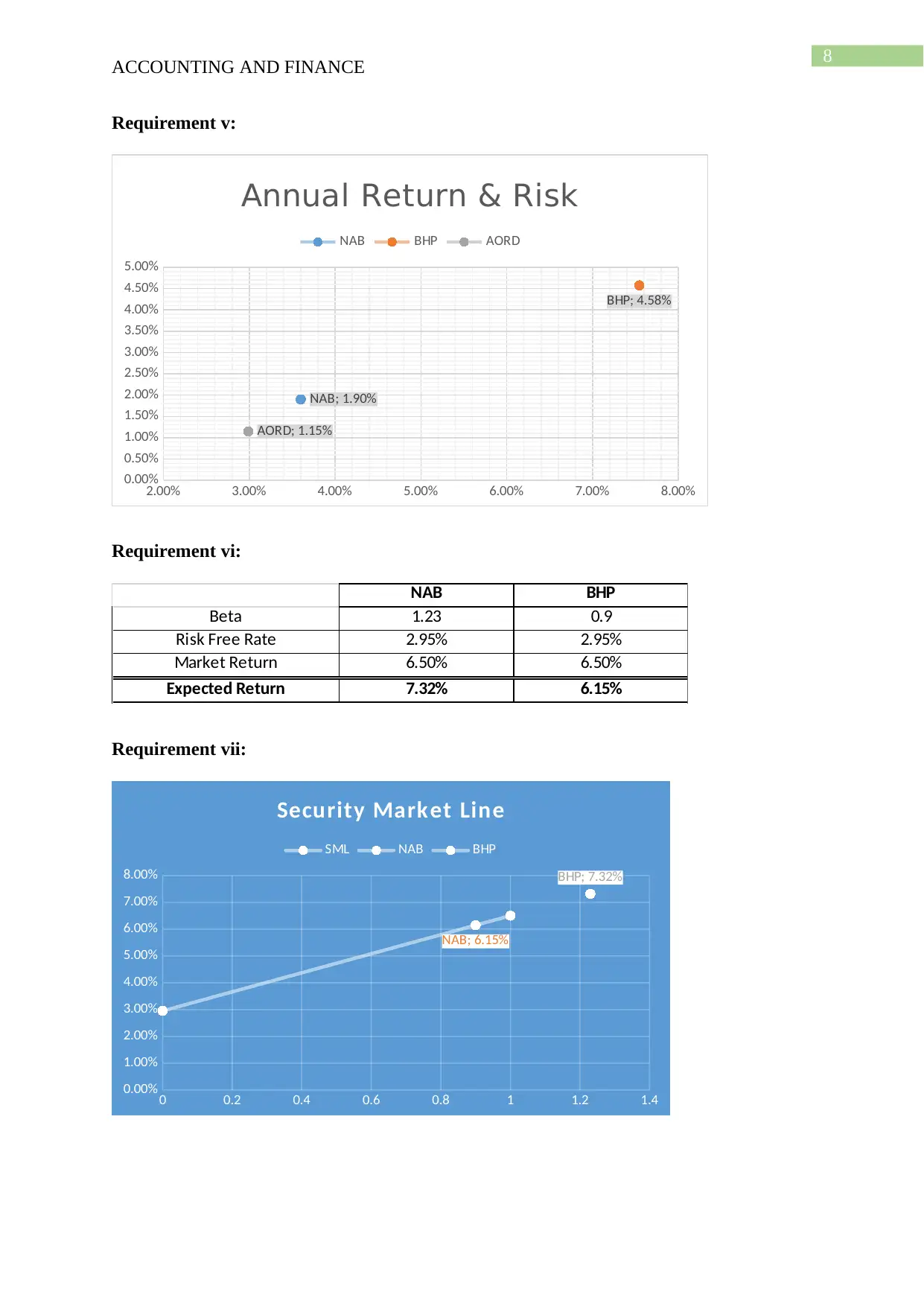
8
ACCOUNTING AND FINANCE
Requirement v:
2.00% 3.00% 4.00% 5.00% 6.00% 7.00% 8.00%
0.00%
0.50%
1.00%
1.50%
2.00%
2.50%
3.00%
3.50%
4.00%
4.50%
5.00%
AORD; 1.15%
BHP; 4.58%
NAB; 1.90%
Annual Return & Risk
NAB BHP AORD
Requirement vi:
Beta
Risk Free Rate
Market Return
Expected Return
NAB BHP
1.23
2.95%
6.50%
7.32%
0.9
2.95%
6.50%
6.15%
Requirement vii:
0 0.2 0.4 0.6 0.8 1 1.2 1.4
0.00%
1.00%
2.00%
3.00%
4.00%
5.00%
6.00%
7.00%
8.00% BHP; 7.32%
NAB; 6.15%
Security Market Line
SML NAB BHP
ACCOUNTING AND FINANCE
Requirement v:
2.00% 3.00% 4.00% 5.00% 6.00% 7.00% 8.00%
0.00%
0.50%
1.00%
1.50%
2.00%
2.50%
3.00%
3.50%
4.00%
4.50%
5.00%
AORD; 1.15%
BHP; 4.58%
NAB; 1.90%
Annual Return & Risk
NAB BHP AORD
Requirement vi:
Beta
Risk Free Rate
Market Return
Expected Return
NAB BHP
1.23
2.95%
6.50%
7.32%
0.9
2.95%
6.50%
6.15%
Requirement vii:
0 0.2 0.4 0.6 0.8 1 1.2 1.4
0.00%
1.00%
2.00%
3.00%
4.00%
5.00%
6.00%
7.00%
8.00% BHP; 7.32%
NAB; 6.15%
Security Market Line
SML NAB BHP
⊘ This is a preview!⊘
Do you want full access?
Subscribe today to unlock all pages.

Trusted by 1+ million students worldwide
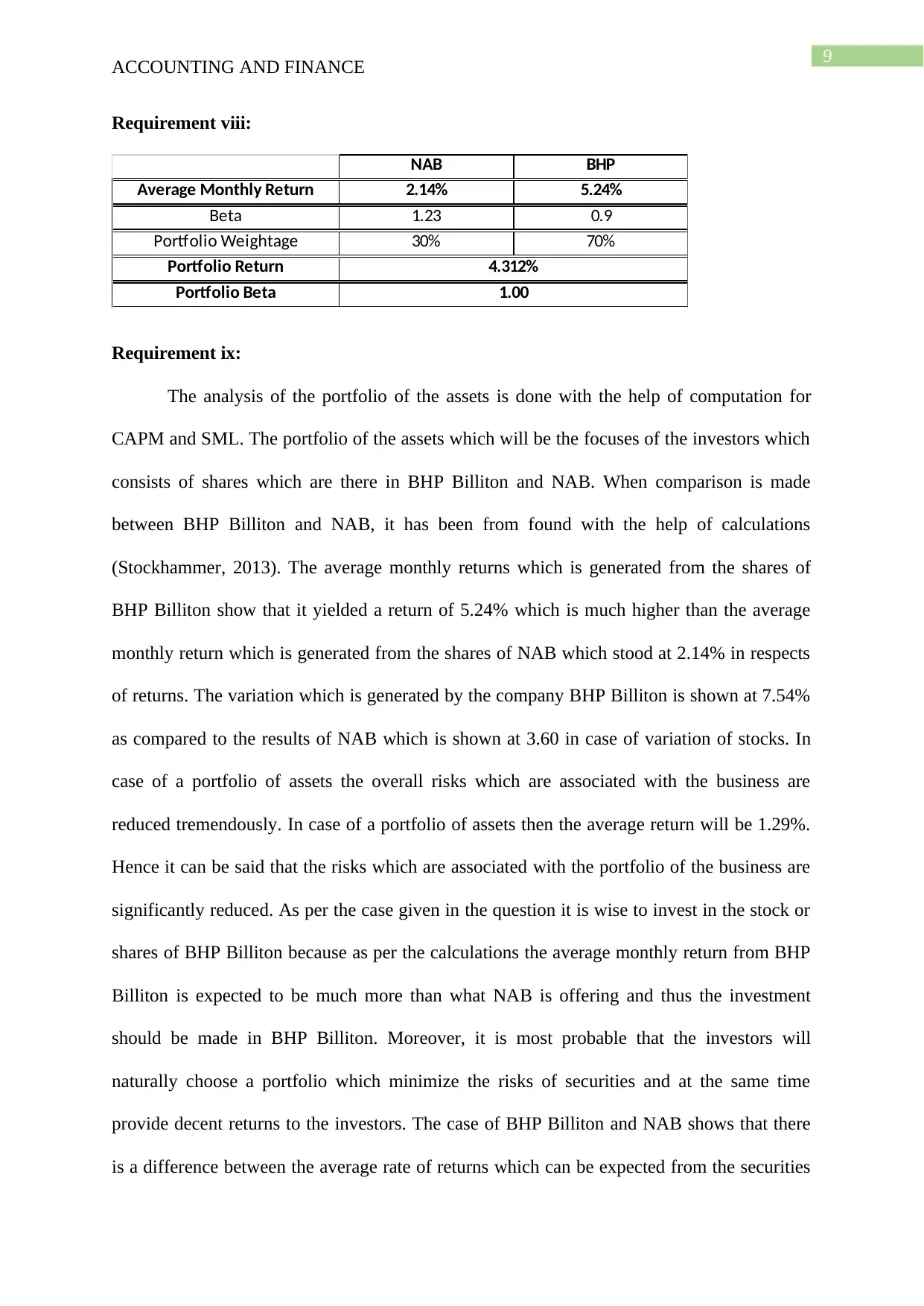
9
ACCOUNTING AND FINANCE
Requirement viii:
Average Monthly Return
Beta
Portfolio Weightage
Portfolio Return
Portfolio Beta
NAB BHP
4.312%
1.00
2.14%
1.23
70%30%
5.24%
0.9
Requirement ix:
The analysis of the portfolio of the assets is done with the help of computation for
CAPM and SML. The portfolio of the assets which will be the focuses of the investors which
consists of shares which are there in BHP Billiton and NAB. When comparison is made
between BHP Billiton and NAB, it has been from found with the help of calculations
(Stockhammer, 2013). The average monthly returns which is generated from the shares of
BHP Billiton show that it yielded a return of 5.24% which is much higher than the average
monthly return which is generated from the shares of NAB which stood at 2.14% in respects
of returns. The variation which is generated by the company BHP Billiton is shown at 7.54%
as compared to the results of NAB which is shown at 3.60 in case of variation of stocks. In
case of a portfolio of assets the overall risks which are associated with the business are
reduced tremendously. In case of a portfolio of assets then the average return will be 1.29%.
Hence it can be said that the risks which are associated with the portfolio of the business are
significantly reduced. As per the case given in the question it is wise to invest in the stock or
shares of BHP Billiton because as per the calculations the average monthly return from BHP
Billiton is expected to be much more than what NAB is offering and thus the investment
should be made in BHP Billiton. Moreover, it is most probable that the investors will
naturally choose a portfolio which minimize the risks of securities and at the same time
provide decent returns to the investors. The case of BHP Billiton and NAB shows that there
is a difference between the average rate of returns which can be expected from the securities
ACCOUNTING AND FINANCE
Requirement viii:
Average Monthly Return
Beta
Portfolio Weightage
Portfolio Return
Portfolio Beta
NAB BHP
4.312%
1.00
2.14%
1.23
70%30%
5.24%
0.9
Requirement ix:
The analysis of the portfolio of the assets is done with the help of computation for
CAPM and SML. The portfolio of the assets which will be the focuses of the investors which
consists of shares which are there in BHP Billiton and NAB. When comparison is made
between BHP Billiton and NAB, it has been from found with the help of calculations
(Stockhammer, 2013). The average monthly returns which is generated from the shares of
BHP Billiton show that it yielded a return of 5.24% which is much higher than the average
monthly return which is generated from the shares of NAB which stood at 2.14% in respects
of returns. The variation which is generated by the company BHP Billiton is shown at 7.54%
as compared to the results of NAB which is shown at 3.60 in case of variation of stocks. In
case of a portfolio of assets the overall risks which are associated with the business are
reduced tremendously. In case of a portfolio of assets then the average return will be 1.29%.
Hence it can be said that the risks which are associated with the portfolio of the business are
significantly reduced. As per the case given in the question it is wise to invest in the stock or
shares of BHP Billiton because as per the calculations the average monthly return from BHP
Billiton is expected to be much more than what NAB is offering and thus the investment
should be made in BHP Billiton. Moreover, it is most probable that the investors will
naturally choose a portfolio which minimize the risks of securities and at the same time
provide decent returns to the investors. The case of BHP Billiton and NAB shows that there
is a difference between the average rate of returns which can be expected from the securities
Paraphrase This Document
Need a fresh take? Get an instant paraphrase of this document with our AI Paraphraser

10
ACCOUNTING AND FINANCE
of both the companies and it is on the basis of this information that the decision of investing
in one of such a shares or portfolio is to be taken (Rutterford & Sotiropoulos, 2016).
ACCOUNTING AND FINANCE
of both the companies and it is on the basis of this information that the decision of investing
in one of such a shares or portfolio is to be taken (Rutterford & Sotiropoulos, 2016).
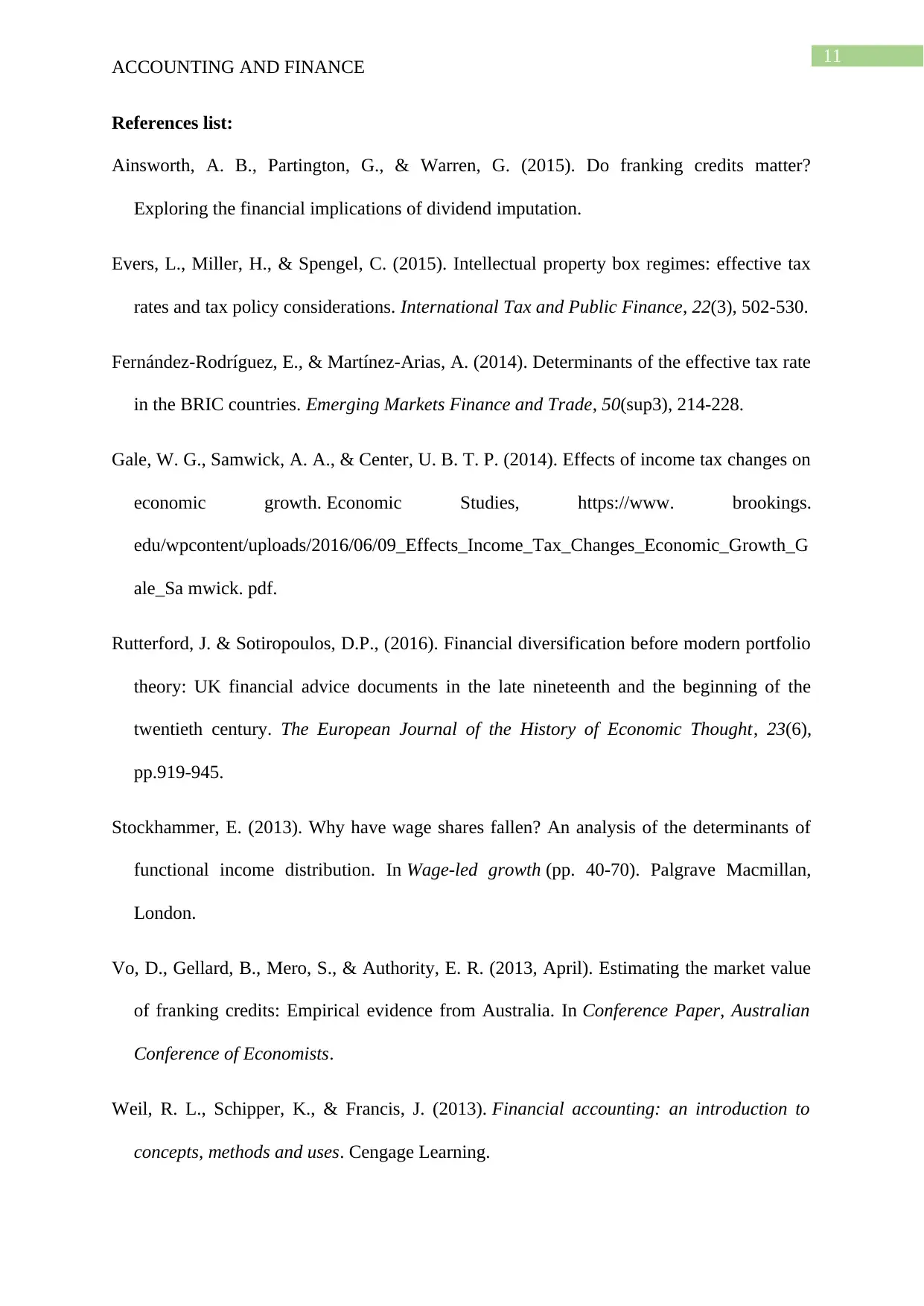
11
ACCOUNTING AND FINANCE
References list:
Ainsworth, A. B., Partington, G., & Warren, G. (2015). Do franking credits matter?
Exploring the financial implications of dividend imputation.
Evers, L., Miller, H., & Spengel, C. (2015). Intellectual property box regimes: effective tax
rates and tax policy considerations. International Tax and Public Finance, 22(3), 502-530.
Fernández-Rodríguez, E., & Martínez-Arias, A. (2014). Determinants of the effective tax rate
in the BRIC countries. Emerging Markets Finance and Trade, 50(sup3), 214-228.
Gale, W. G., Samwick, A. A., & Center, U. B. T. P. (2014). Effects of income tax changes on
economic growth. Economic Studies, https://www. brookings.
edu/wpcontent/uploads/2016/06/09_Effects_Income_Tax_Changes_Economic_Growth_G
ale_Sa mwick. pdf.
Rutterford, J. & Sotiropoulos, D.P., (2016). Financial diversification before modern portfolio
theory: UK financial advice documents in the late nineteenth and the beginning of the
twentieth century. The European Journal of the History of Economic Thought, 23(6),
pp.919-945.
Stockhammer, E. (2013). Why have wage shares fallen? An analysis of the determinants of
functional income distribution. In Wage-led growth (pp. 40-70). Palgrave Macmillan,
London.
Vo, D., Gellard, B., Mero, S., & Authority, E. R. (2013, April). Estimating the market value
of franking credits: Empirical evidence from Australia. In Conference Paper, Australian
Conference of Economists.
Weil, R. L., Schipper, K., & Francis, J. (2013). Financial accounting: an introduction to
concepts, methods and uses. Cengage Learning.
ACCOUNTING AND FINANCE
References list:
Ainsworth, A. B., Partington, G., & Warren, G. (2015). Do franking credits matter?
Exploring the financial implications of dividend imputation.
Evers, L., Miller, H., & Spengel, C. (2015). Intellectual property box regimes: effective tax
rates and tax policy considerations. International Tax and Public Finance, 22(3), 502-530.
Fernández-Rodríguez, E., & Martínez-Arias, A. (2014). Determinants of the effective tax rate
in the BRIC countries. Emerging Markets Finance and Trade, 50(sup3), 214-228.
Gale, W. G., Samwick, A. A., & Center, U. B. T. P. (2014). Effects of income tax changes on
economic growth. Economic Studies, https://www. brookings.
edu/wpcontent/uploads/2016/06/09_Effects_Income_Tax_Changes_Economic_Growth_G
ale_Sa mwick. pdf.
Rutterford, J. & Sotiropoulos, D.P., (2016). Financial diversification before modern portfolio
theory: UK financial advice documents in the late nineteenth and the beginning of the
twentieth century. The European Journal of the History of Economic Thought, 23(6),
pp.919-945.
Stockhammer, E. (2013). Why have wage shares fallen? An analysis of the determinants of
functional income distribution. In Wage-led growth (pp. 40-70). Palgrave Macmillan,
London.
Vo, D., Gellard, B., Mero, S., & Authority, E. R. (2013, April). Estimating the market value
of franking credits: Empirical evidence from Australia. In Conference Paper, Australian
Conference of Economists.
Weil, R. L., Schipper, K., & Francis, J. (2013). Financial accounting: an introduction to
concepts, methods and uses. Cengage Learning.
⊘ This is a preview!⊘
Do you want full access?
Subscribe today to unlock all pages.

Trusted by 1+ million students worldwide
1 out of 12
Related Documents
Your All-in-One AI-Powered Toolkit for Academic Success.
+13062052269
info@desklib.com
Available 24*7 on WhatsApp / Email
![[object Object]](/_next/static/media/star-bottom.7253800d.svg)
Unlock your academic potential
Copyright © 2020–2025 A2Z Services. All Rights Reserved. Developed and managed by ZUCOL.




